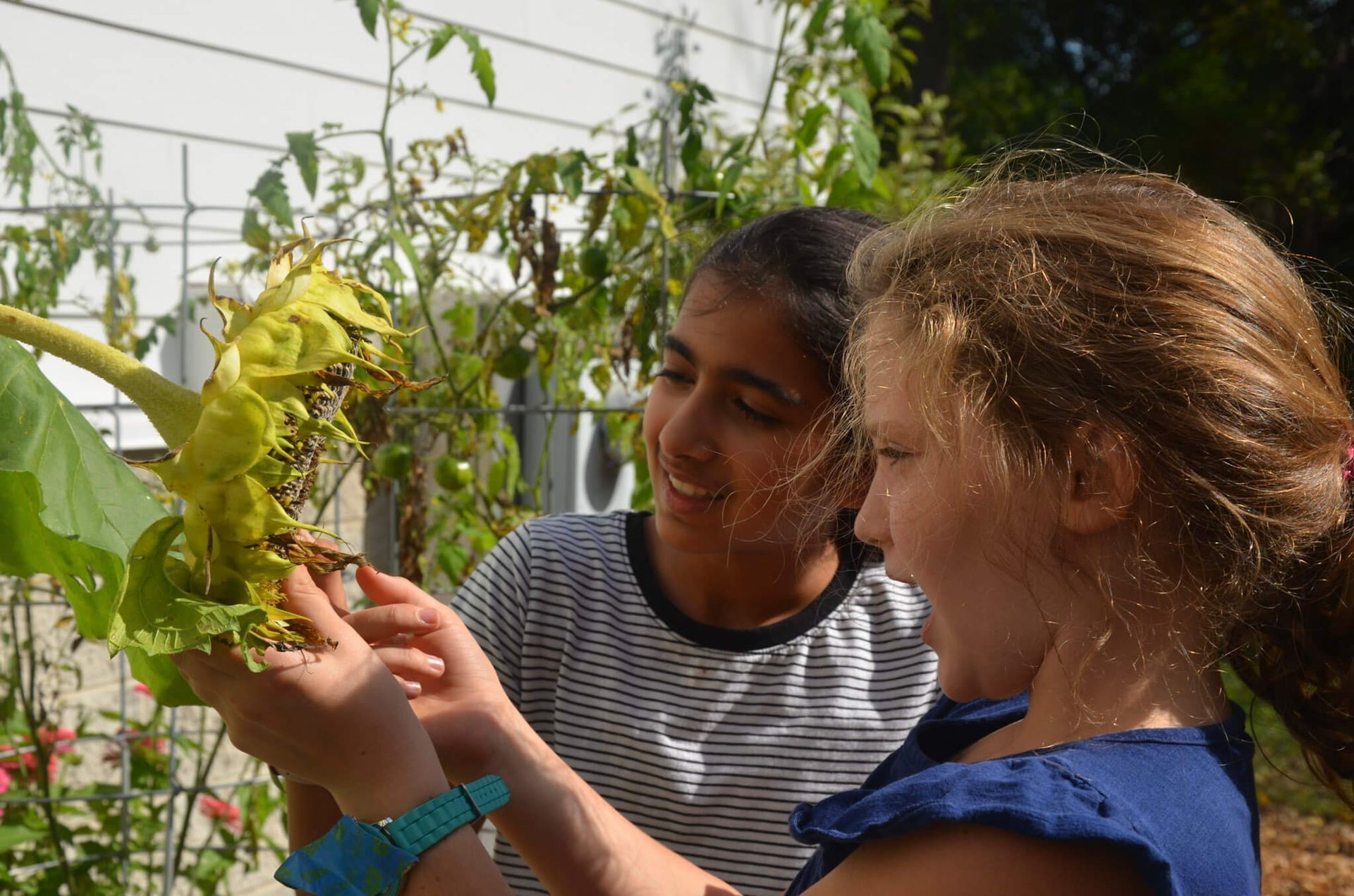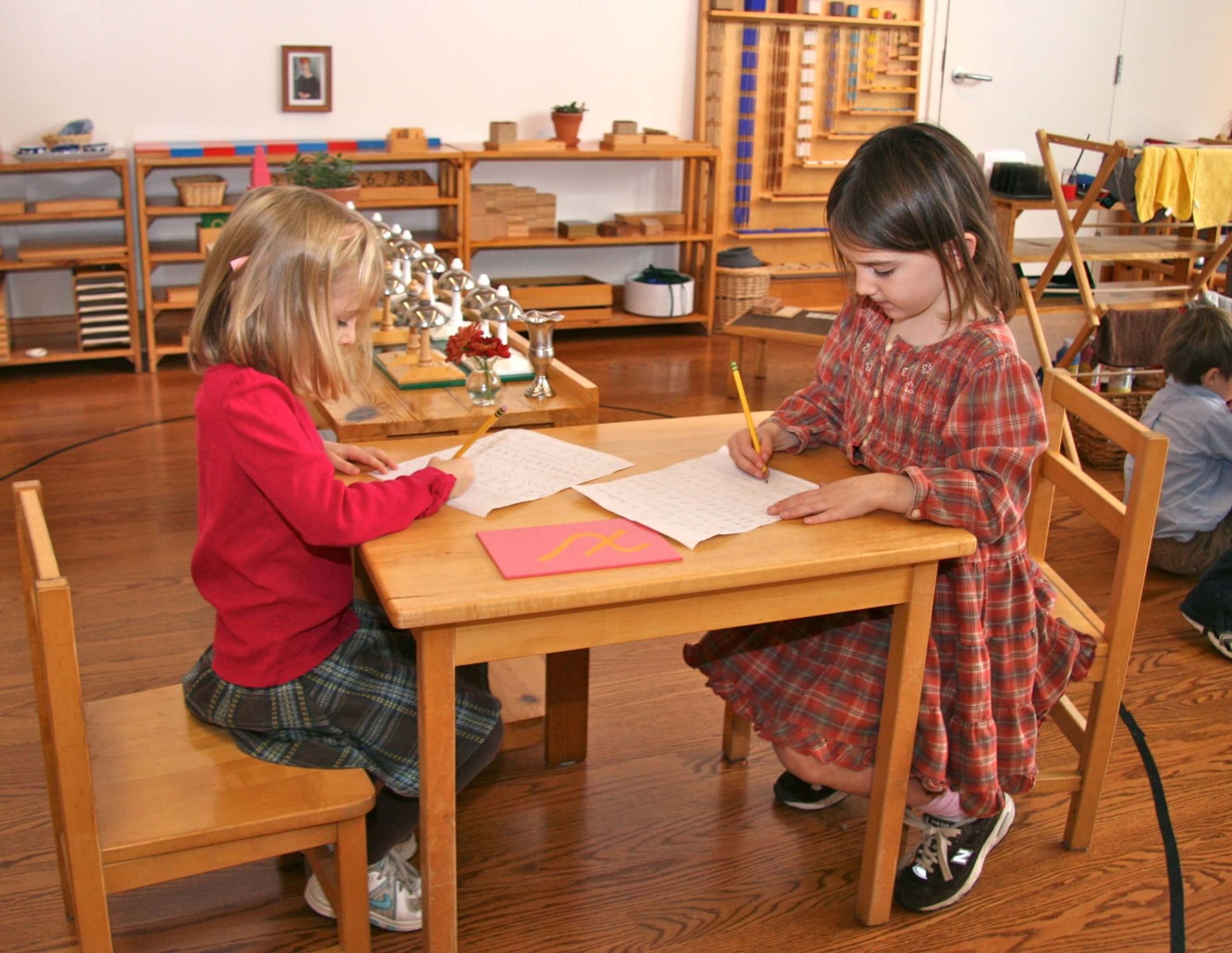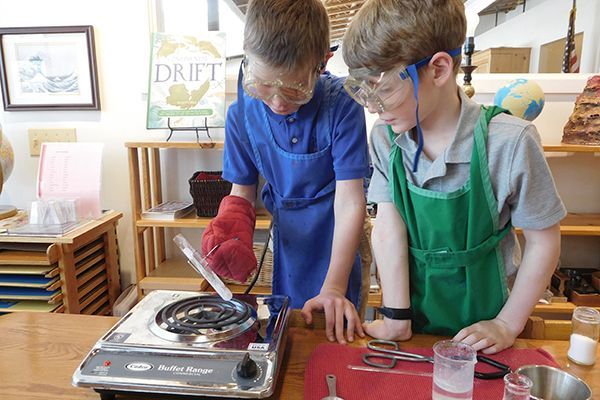
When transcribing notes from a recent alumni panel discussion, I realized that two words came up so often that one might mistakenly think we asked the panelists ahead of time to please focus on them! These were curiosity and courage. Of course, many other themes arose–and often do–when discussing Montessori’s effects on students long-term. But these two intertwined traits are imperative in today’s world, and they deserve some attention here. Without curiosity and courage, we cannot adapt and progress through the pandemic, or through the economic distress, political and social strife, or the environmental concerns that we face.
So, how exactly does the Montessori approach foster the two traits of curiosity and courage? Let’s look at curiosity, how curiosity is fostered by thinking and reflecting, how it supports creativity, and at courage and how agency and challenge build one’s courage.
Curiosity
We all begin life with an inborn curiosity. Children are undeniably curious; it may be safe to say that curiosity is a natural trait of childhood. And like any character trait in life, curiosity can be discouraged–or encouraged–to develop further. In my own experiences of conventional school, curiosity was discouraged when my childhood teachers didn’t “call on” me in class when my hand was raised, and by the idea that there was usually only one “correct answer” to a question; once it was declared, the discussion was over and the teacher moved on. I was discouraged from being curious by having questions written out for me; every worksheet, textbook or quiz already had the questions that I was supposed to pursue and answer. There was little time for me to look for answers to original questions, or to even think of what my own questions might be. No one presented resources for where I might seek out answers…everything was prescribed and laid out ahead of time. All I was supposed to do to be a “good student” was go along with what was set up for me. I was never explicitly invited to come up with my own, original questions.
This wasn’t the greatest preparation for adulthood. Out in the real world, asking original questions leads people to make new discoveries, to solve difficult problems, and to make improvements. In The Innovator’s DNA, authors Jeff Dyer, Hal Gregersen and Clayton Christensen describe how a young man learned to think up and write down several questions each night for work the next day. By asking his team questions every morning, this young man got the group thinking of solutions. But more than that, he began thinking with curiosity, he primed his thinking. The authors explain that priming one’s thinking by fostering curiosity and asking questions enhances one’s ability to be creative and then to come up with new solutions. As The Innovator’s DNA explains, this exercise has proven to make business teams more successful across the board.
I do not fault my childhood teachers for not fostering my curiosity; I am sure they would have loved to have been able to encourage curiosity and originality in their students. But the framework and timetable my childhood teachers were given for passing along information did not allow for this. It was the conventional school system we were all in.
By contrast, the Montessori approach fosters curiosity in deliberate ways, every day and at all age levels. Montessori children are actively primed to think! The classroom environments invite children to explore,both physically and mentally. The Montessori directors are trained to model curiosity in how they present materials and with the questions they ask aloud. Montessori teachers are encouraged to follow their own curiosity to learn about topics alongside their students, making them living examples.
Montessori graduate Grace Kasten explains that having the freedom to follow one’s interests prepared her well to seek a deeper understanding of whatever she’s doing now:
"[We were] allowed to study and learn about whatever we wanted to for extended periods of time if we desired–we use the term, ‘deep dives,’ now. This ended up fostering a level of curiosity and an actual interest to understand the mechanics of what we were learning."
Grace goes on to explain that this approach to work made her a more thorough and engaged student all through high school and college, and that it guides her every day in her current work as an investment banker.

Fostering Curiosity by Thinking and Reflecting
A main ingredient for developing curiosity is having time and space for thinking and reflecting. In a Montessori setting, children are not rushed from one activity to the next. Even their casual conversations as they greet each other in the morning give children time and space for thinking and asking questions.
During their presentations, Montessori Directors encourage children to ask their many questions. Most elementary presentations actually begin with the Director asking the children a prompting question, such as, “Have you ever wondered about how…” or, “Have you ever noticed….?” Such an opening question is always followed by deliberate pauses for the children to respond and volunteer any other questions this may make them think of. There is lots of encouragement to ask one’s own, authentic questions. Because the answers are not always immediately apparent, a lively search for some answers is the natural next step in the children’s original work.
This practice leads directly to what some of our graduates in the recent alumni panel report: that they tend now–as adults–to ask a lot of questions and to wonder, “why” in all sorts of business and work-related situations. Another Montessori graduate, Reeve Waud, tells us that he constantly asks his business school colleagues, “Why do we do it that way in business?” He wants to really get to the bottom of the systems in place and to understand their purposes. He is always wondering, “Is there perhaps a better way? Could we improve? If so, how?” Having grown up always exploring in his Montessori education, Reeve is an adult who passionately continues to explore.
How Curiosity Supports Creativity
Curiosity and creativity are closely linked. Creativity is key for succeeding in a rapidly changing world where innovation and creative problem solving are imperative for survival. In The Innovator’s DNA, the authors researched the businesses and leaders who have been most successful in the past fifteen years and tell us:
“The key insight from our research is that creativity is not just a cognitive skill endowed by genetics. It is powerfully rooted in your behaviors–and in particular the extent to which you engage in questioning, observing, networking, and experimenting. Change your behaviors and you can change your creative capacity.”
Our graduates have felt the validity of such habits in their adult lives. Reeve says, “It’s…important to be able to operate independently, which we learned at Forest Bluff...and allow your curiosity to take you different places, a skill that’s very important to learn early on."
The tendency to ask questions is a fundamental prerequisite to creative thinking. Creative problem-solving grows out of honest curiosity. To begin any process of making new discoveries, one has to be curious, and then, he or she must have courage to take the next step...
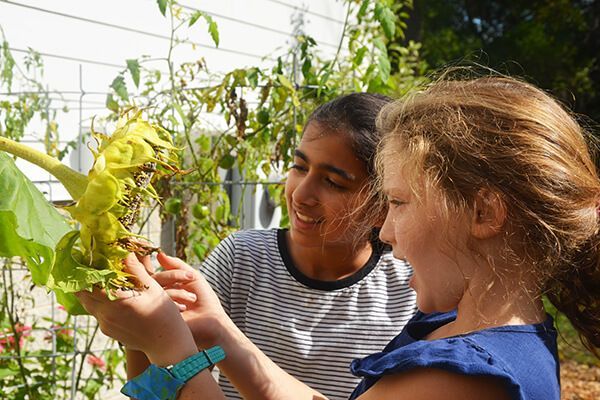
Courage
Courage is essential when facing the unknowns. Another one of our graduates, Luke Corsiglia, tells us that he has found this to be true. Having courage means being willing to be wrong to start out on a quest for new information and experimentation. As a mechanical engineer, Luke says that he can wake up in the morning and create any system that he thinks might work for a certain problem. In a field such as engineering, there is no set plan or specific blueprint when looking for a new solution. This is very uncomfortable, Luke says, for some of his colleagues at work.
Luke says, "Being comfortable with uncertainty... I see it a lot in some younger engineers I work with, they're not comfortable with that... When they get thrown into this environment where you've got some rough guidelines, but no real specifics from a design perspective, being able to wrap your head around where to go... they just get a little lost, and they're not comfortable with that scenario, that we've got to figure out what we're doing while we're getting to the result, and that's something I never have a problem with." Having grown up in a Montessori environment, he says, enables him to be at home with uncertainty of outcomes, and to be courageous in his work.
Reeve shares the same sentiment when he reflects on the role uncertainty plays in learning. He says, "Being comfortable not knowing the answer to something is one of the things Montessori really instilled in us. Then we were comfortable enough knowing we didn't know it, and then wanted to figure out why we didn't know it."
For a Montessori graduate, it comes naturally to start exploring and asking questions, to create something new and to try it out. That’s practiced courage.
Montessori teacher John MacNamara has a sign on his classroom wall giving his 7th and 8th graders a mantra he believes gives them courage: “If you can’t be right, be wrong.” In other words, don’t be afraid to be wrong, just try something, and go from there! You may have lots of failures along your path to success.
This is how courage is fostered in Montessori, where mistakes are welcomed as natural parts of any process. You may be familiar with Albert Einstein’s quote, “Failure is success in progress.” Indeed, many must fail, sometimes multiple times, in order to create something of value. Maria Montessori wrote, “Every great cause is born from repeated failures and from imperfect achievements.” Think of the great inventions and solutions to problems that would never have been if their creators lacked the courage to push through their failures!
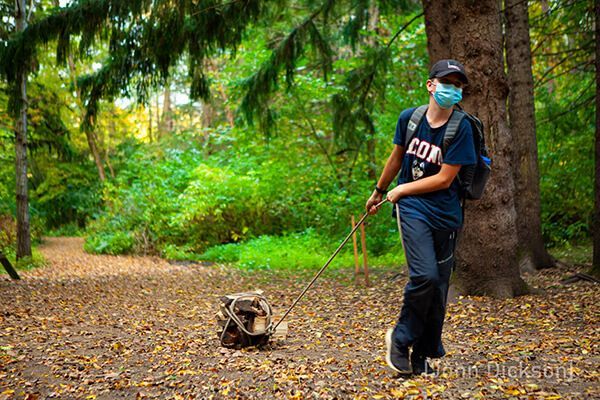
How Agency and Challenge Build Courage
Montessori students are given many choices and a lot of autonomy, from their earliest years up through their Secondary Level trips at age 14. This helps them build their confidence gradually over the years. Graduate Kallan Benjamin explains:
"Being allowed to feel like you had a lot of agency at a really young age enables you to make really strong, positive decisions. That's what occurred on our trips."
The numerous experiences of making a choice of what work to do when children walk into a classroom each day, how long to work on it, and when they determine they are finished, leads into the Secondary Level adolescent’s decisions about what work needs to be done for a trip, when and how to take care of themselves and each other, and what steps to take in a trip project. Kallan also tells us that her courage was fostered further through the challenges she encountered in Montessori’s Secondary Level program. The trips were very challenging, by design, and managing through them was impactful for her:
"Knowing that I did that [made it through the intense/tough Secondary Level trips] has got to give us some confidence that we were capable of managing that level of responsibility at that age, and having fun with it, too, when it was so tough..."
Building that courage made Kallan feel better prepared for high school and for her adult life.
Courage also forms when a young person feels confident from knowing herself well. The pauses and the time offered for reflection in Montessori classrooms offers children what Grace calls, “pure moments” in life. Grace says that through these reflective pauses, she developed:
"A level of self-awareness, and being able to know yourself on a really deep level, and how you fit into the world and how the world moves around you. There were a lot of pure moments [in Montessori]. Having pure moments in life-- reading outside, sitting on the floor singing together, packing your own lunch-- made you feel more in touch with yourself."
This self-awareness, coupled with being respected by the adults around them, helps Montessori students build more courage. Grace tells us that she and her classmates developed a level of comfort interacting with adults that other young adults don’t always seem to have. This stems from Montessori teachers encouraging children to come up with their own questions, and to pursue original answers to them. This act alone is one of ultimate respect for each individual. We must foster and encourage this originality if we are going to bring every person’s gifts to the table.
Encouraging curiosity and courage is one of the most powerful strengths of an authentic Montessori education. By preparing young people to tackle the world’s problems from a place of practiced curiosity, we can feed the next generation with valuable skills. By giving them explicit opportunities to build courageous personalities, Montessori gives the next generation the strength to make this word a better place for all.

